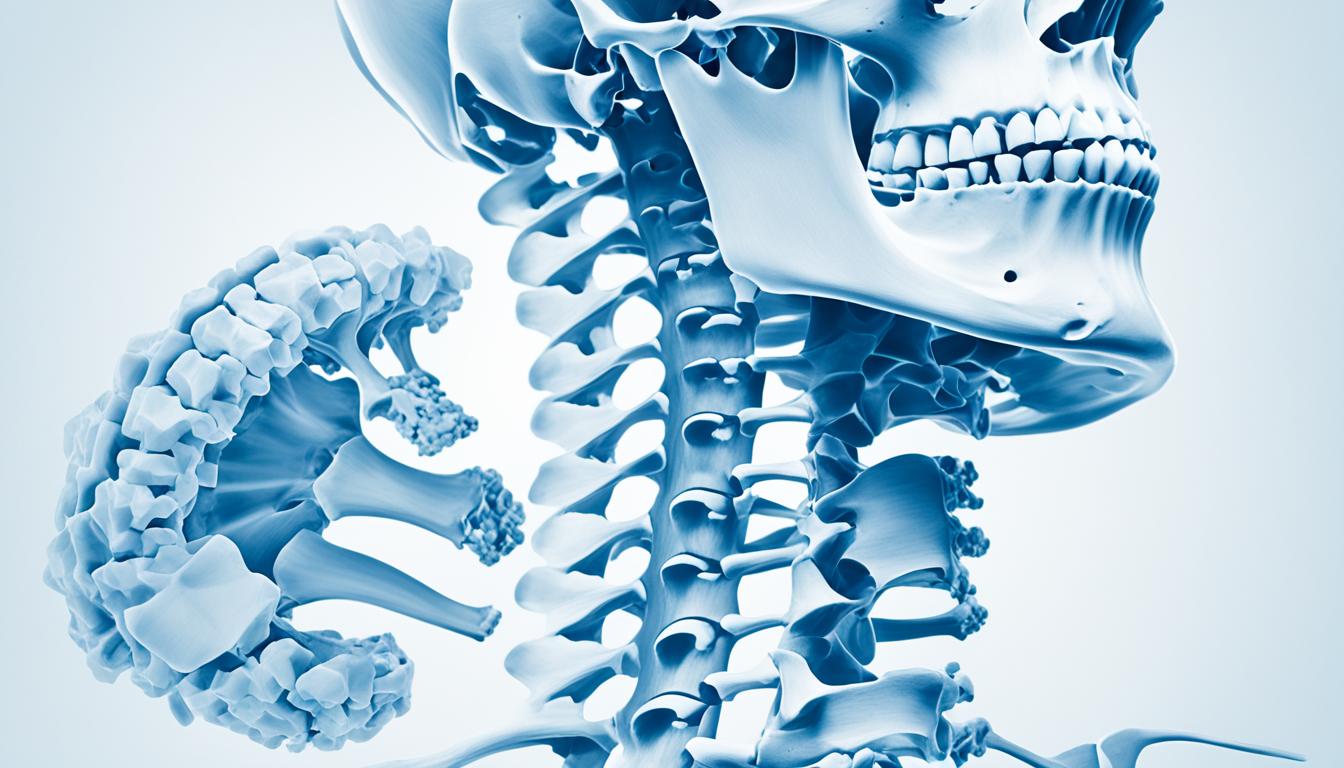Cervical osteoarthritis is a common joint condition. It affects the neck’s bones, joints, and discs. Age-related wear and tear in the neck’s spine causes this. This wear leads to the breakdown of cushioning cartilage between bones.
People with this condition may feel neck pain and stiffness. They might also find it hard to move their neck. Sometimes, the pain spreads to the shoulders or arms. These symptoms can be mild or severe and affect daily life.
To diagnose cervical osteoarthritis, doctors use X-rays or MRI scans. These tests show changes in the neck’s spine. Knowing these changes helps doctors plan the right treatment.
Treatments for this condition include both non-drug and drug options. Non-drug treatments include losing weight and doing specific exercises. Lifestyle changes are also part of this therapy. For drug treatments, nonsteroidal anti-inflammatory drugs (NSAIDs) can help reduce pain and inflammation.
If the above methods don’t work, doctors might consider more invasive options. These can include steroid shots in the neck or surgery. However, surgery is usually the last option for severe cases.
Stem cell therapy is a new way to treat cervical osteoarthritis. It involves injecting stem cells into the affected joint areas. This treatment can help repair tissues and reduce symptoms. It aims to fix damaged cartilage, which could make it a good alternative to standard treatments.
Key Takeaways:
- Cervical osteoarthritis is a common degenerative joint condition affecting the bones, joints, and discs of the neck.
- It is primarily caused by age-related wear and tear in the cervical spine.
- Common symptoms include neck pain, stiffness, limited mobility, and radiating pain to the shoulders or arms.
- Diagnosis is confirmed through radiographic imaging, such as X-rays or MRI scans.
- Treatment options range from nonpharmacologic therapies to pharmacologic therapies, and in severe cases, invasive interventions may be necessary.
- Stem cell therapy is an emerging treatment approach that aims to regenerate damaged cartilage and promote tissue repair.
- Consult with a healthcare professional to determine the most suitable treatment plan for individual cases of cervical osteoarthritis.
Symptoms and Causes of Cervical Osteoarthritis
Cervical osteoarthritis, or cervical spondylosis, causes problems in the neck and nearby areas. It’s key to know these symptoms and their causes. This knowledge helps diagnose and treat the issue.
Symptoms of Cervical Osteoarthritis
The neck is where symptoms of cervical osteoarthritis show up. They can be mild or very painful. Here are the common symptoms:
- Neck pain: It ranges from dull to sharp, shooting pain.
- Stiffness: Turning your head or bending your neck may be hard.
- Limited mobility: Doing regular activities can become tough.
- Radiating pain: This happens when neck pain spreads to the arms due to nerve pressure in the neck.
Causes of Cervical Osteoarthritis
Wear and tear of the cervical spine due to age is a major cause. The neck’s joint and disc cartilage wears down over time. This lead to structural degeneration. Other factors that play a part include:
- Genetics: Some people might inherit a higher risk of cervical osteoarthritis.
- Trauma: Past neck injuries can also raise the risk.
- Repetitive neck movements: Some jobs or activities that do much of the same neck motions may be linked to this condition.
As it gets worse, cervical osteoarthritis can cause bone spurs and a narrow spine canal. This worsens symptoms and limits neck movement more.
| Symptoms | Causes |
|---|---|
| Neck pain | Age-related wear and tear |
| Stiffness | Genetics |
| Limited mobility | Trauma or previous injuries |
| Radiating pain | Repetitive neck movements |
This table shows the typical symptoms and causes of cervical osteoarthritis. Knowing these is crucial for correct diagnosis and treatment.
Diagnosis and Treatment of Cervical Osteoarthritis
Doctors diagnose cervical osteoarthritis, or cervical spondylosis, with X-rays or MRIs. These images show changes in the cervical spine. They confirm the condition. Doctors might also do blood tests or exams to check for other causes of pain.
For treatment, the main aims are to ease pain, boost movement, and stop spine damage. Approaches without medicine are key. They include losing weight, doing physical therapy, changing how you live, and using special devices like a soft collar.
Medicine is also used. Painkillers and NSAIDs manage pain and swelling. For tough cases, shots or surgeries might be needed, like an epidural injection or a spinal fusion.
Stem cell therapy is a new hope for treating cervical osteoarthritis. With stem cells, the goal is to heal tissues and cut down symptoms. This method brings a fresh chance for people looking for other ways to ease their pain.
It’s important to work closely with healthcare experts for the best treatment. Each person’s situation is different. A plan made just for you can bring the best results and make life better.

